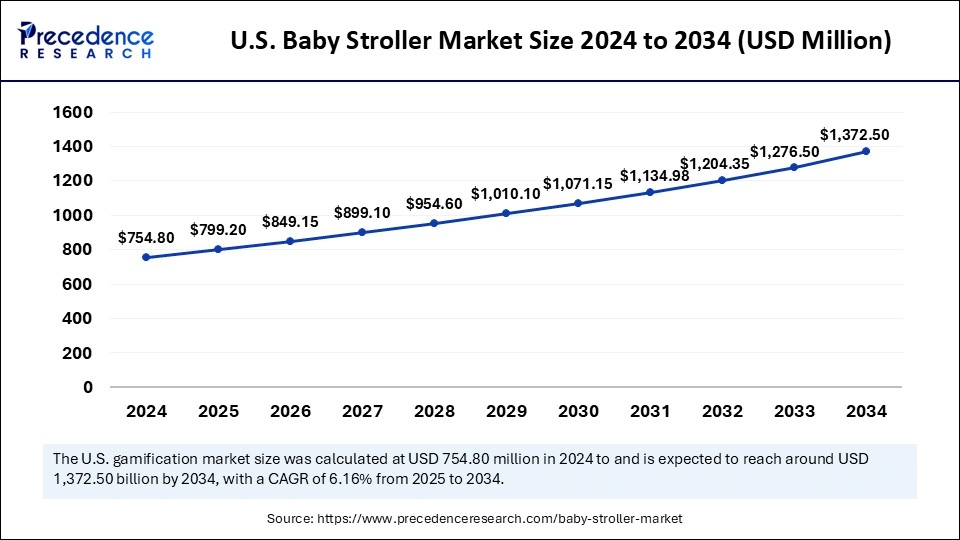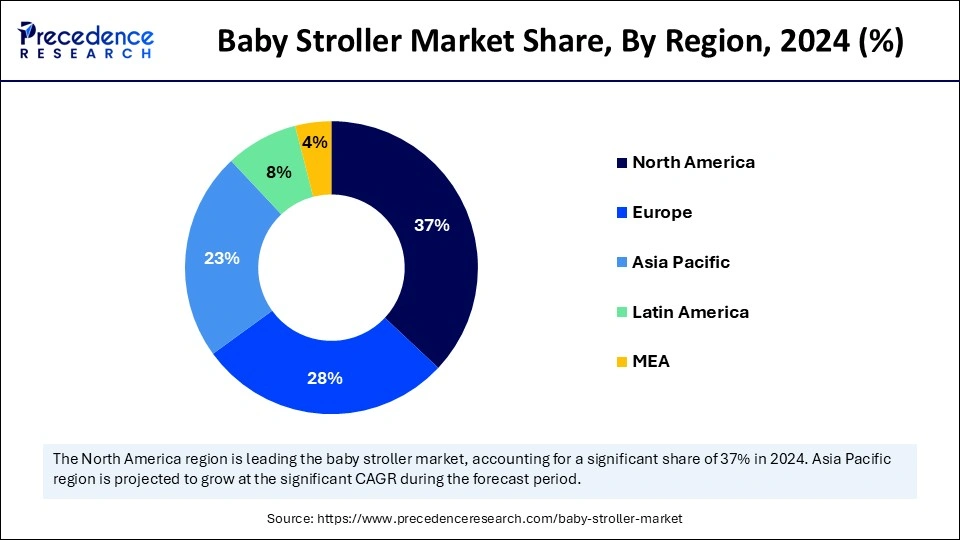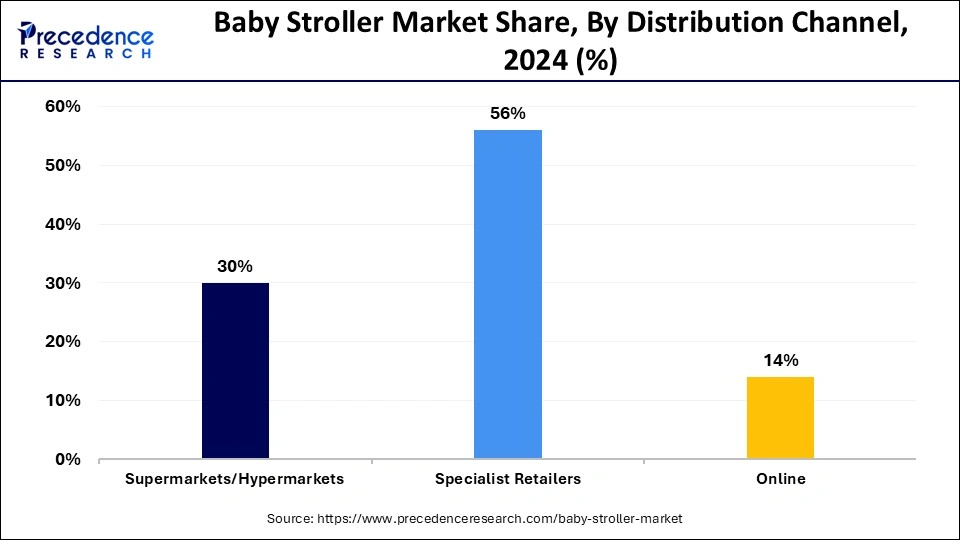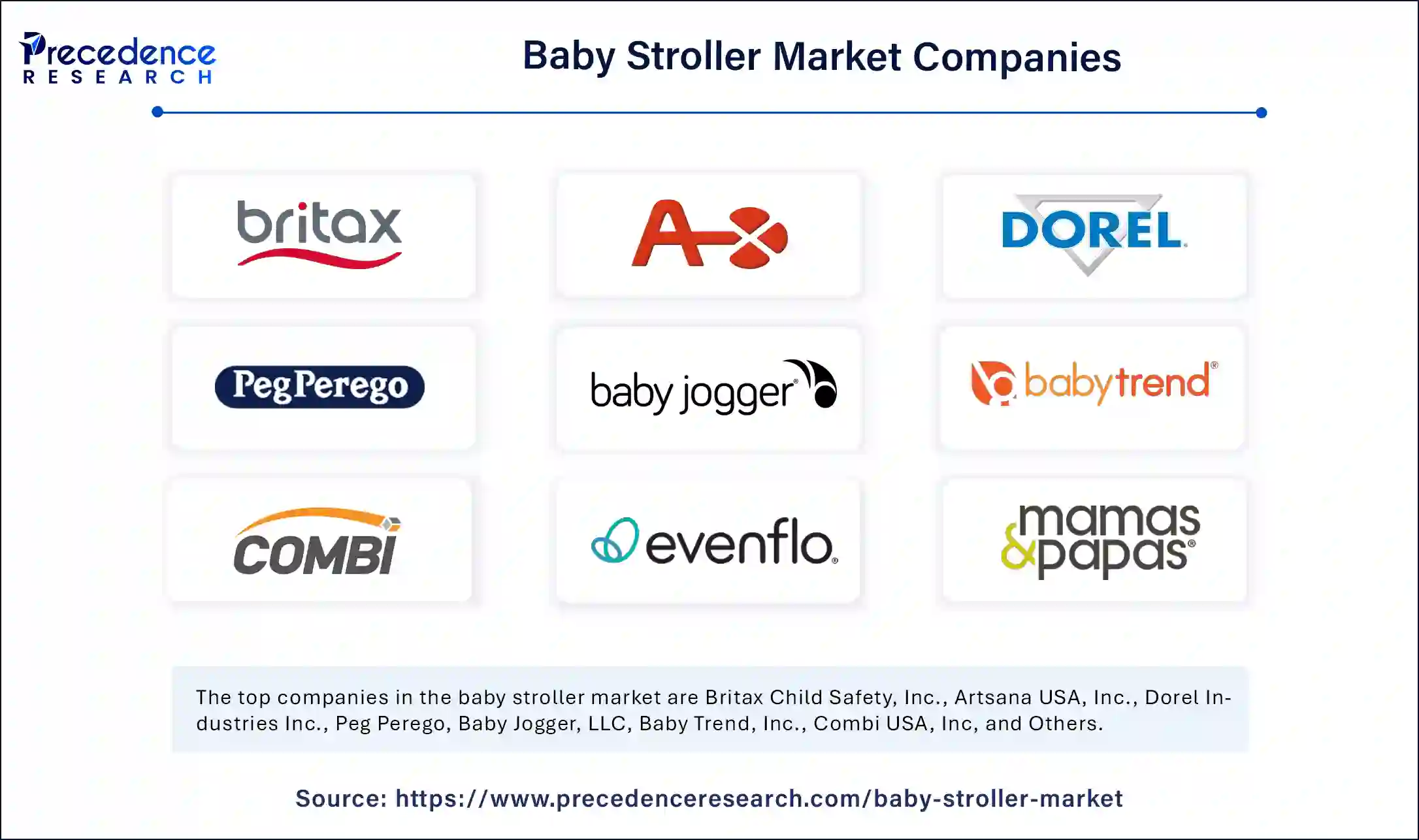September 2024
The global baby stroller market size is accounted at USD 2.88 billion in 2025 and is forecasted to hit around USD 4.88 billion by 2034, representing a CAGR of 6.01% from 2025 to 2034. The North America market size was estimated at USD 1.01 billion in 2024 and is expanding at a CAGR of 6.12% during the forecast period. The market sizing and forecasts are revenue-based (USD Million/Billion), with 2024 as the base year.
The global baby stroller market size accounted for USD 2.72 billion in 2024 and is predicted to increase from USD 2.88 billion in 2025 to approximately USD 4.88 billion by 2034, expanding at a CAGR of 6.01% from 2025 to 2034.The growth of the baby stroller market is driven by the rise in spending on infant care items across the world.

The integration of innovative technologies into daily aspects of life is becoming more common, expanding the scope of applications of artifical intelligence. The adoption of AI technologies can streamline several tasks of daily routine. Integrating AI features transforms baby strollers into smart devices, which enhance convenience for caregivers with self-folding mechanisms, controls through apps, and GPS tracking. These smart strollers can connect with smartphone apps, enabling parents to monitor their babies even from their workspace.
AI-powered smart baby strollers drive themselves, reducing parents’ discomfort. These strollers detect obstacles in the path and alert parents to any immediate hazards. This smart feature further enhances convenience and safety. Many smart strollers come with advanced suspension systems that keep the baby comfortable, even in uneven terrain. Features like integrated speakers and temperature control further add to engagement for the infants while offering comfort at the same time. Thus, AI has the potential to change the landscape of the baby stroller market.
The U.S. baby stroller market size was evaluated at USD 754.80 billion in 2024 and is projected to be worth around USD 1,372.50 billion by 2034, growing at a CAGR of 6.16% from 2025 to 2034.

North America dominated the baby stroller market in 2024. This is mainly due to the high disposable income in the region, allowing parents to invest heavily in premium strollers. The presence of major market players and the easy accessibility to a wide range of baby strollers with advanced features further bolstered regional market growth. The U.S. plays an important role in the North American baby stroller market. The rise in disposable income with dual-income households in the country and the growing awareness of safety for babies are key factors boosting the market growth in the U.S. The rising necessity of efficient and convenient baby transportation solutions is further fueling market growth in the country.
The Asia Pacific baby stroller market is poised to witness the fastest growth during the forecast period. The rising birth rates and rapid urbanization in Asian countries are anticipated to propel the growth of the market in the region. Growing economies, rising disposable incomes, and heightened awareness about child safety among the population further boost market growth. The rapid expansion of e-commerce businesses is also boosting accessibility to a wide range of baby strollers.

India is expected to have a stronghold on the market. Moreover, rapid urbanization and increasing per capita income are likely to support the market in India. For instance, India’s per capita income grew by 8% in FY2024. Well-established baby care brands and efforts of regional market players to expand their footprints are expected to support market growth in the country. In addition, the growing number of dual-income families and the rising tech-savvy population are expected to boost the demand for baby strollers with advanced safety features.
Europe is projected to witness notable growth in the foreseeable future. There is a high focus on child safety, which is expected to boost the demand for high-quality baby strollers. A rise in working parents’ populations and the increasing disposable income support the European baby stroller market growth. The heightened need for easy and convenient transportation solutions for infants and rising preferences for innovative products will contribute to market expansion. The established network of specialized baby product stores and online retailers across the region further supports regional market growth. Germany is anticipated to play a major part in the market in Europe. The increasing demand for premium products and the presence of numerous retail stores that stock baby strollers are anticipated to support market growth in the country
The baby stroller market has witnessed rapid growth over the years. The convenience and ease of transportation that baby strollers provide make them a popular choice among parents. The rising consumer disposable income across the world is boosting the growth of this market. The growing concerns among parents about the safety and comfort of their babies are expected to boost the growth of the market. Parents are increasingly prioritizing the safety and comfort of their babies, leading to the increased adoption of baby strollers, especially with smart features like self-folding mechanisms, autonomous drive, and alert systems. The comfort and ease of maneuverability of these strollers make them a preferred choice, especially in urban areas.
Changing consumer preferences can significantly impact the market. As consumer preferences change, so does the desire for new features. Busy lifestyles encourage people to seek baby strollers that are easy to fold and maneuver, while tech-savvy people often prioritize smart features. Moreover, key players operating in the market are constantly expanding their product portfolio to cater to varying consumer demands.
| Report Coverage | Details |
| Market Size by 2034 | USD 4.88 Billion |
| Market Size in 2025 | USD 2.88 Billion |
| Market Size in 2024 | USD 2.72 Billion |
| Market Growth Rate from 2025 to 2034 | CAGR of 6.01% |
| Dominated Region | North America |
| Fastest Growing Market | Asia Pacific |
| Base Year | 2024 |
| Forecast Period | 2025 to 2034 |
| Segments Covered | Product, Distribution Channel, and Regions |
| Regions Covered | North America, Europe, Asia-Pacific, Latin America and Middle East & Africa |
Increased Disposable Income
The rising disposable income is one of the major factors driving the growth of the baby stroller market. As disposable income rises, the purchasing power of consumers also rises, encouraging them to spend on high-quality baby products. The rising number of dual-income families is expected to support market growth. Dual-income families often have high disposable income, encouraging them to invest in safety and convenience features for their babies, leading to increased demand for baby strollers. In addition, the increasing number of childcare centers, especially in emerging and highly urbanized countries, drives the growth of the market. Childcare centers often require baby strollers to transport children for outdoor activities. The rising government initiatives to support childcare centers, including grants and funding, further contribute to market growth.
Economic Challenges
Economic challenges, including low disposable income, especially in underserved areas, hamper the growth of the baby stroller market. In regions where the substantial population lives in rural areas with lower disposable income choose not to spend too much on infant care. People in such areas often focus on traditional childcare practices, limiting baby strollers' adoption. The penetration of the market in such regions is extremely low because people cannot afford baby strollers due to their high costs. In fact, premium or smart baby strollers are costlier, discouraging potential buyers, including middle-income people, from investing in them.
Rising Demand for Sustainable Products
Increasing environmental awareness creates immense opportunities for baby stroller manufacturers. As people are becoming more aware of the environmental impact of their purchasing, they are shifting their preferences toward sustainable options. This, in turn, boosts the demand for baby strollers made from recycled materials, non-toxic components, and natural materials, such as wood. This further helps manufacturers to expand their product portfolio and tap into those marketplaces where eco-conscious population is rapidly growing.
The lightweight segment dominated the baby stroller market with the largest share in 2024. Lightweight baby strollers are preferred for their ease of use and convenience. Modern parents often prioritize convenience, making lightweight strollers a popular choice. These strollers can be maneuvered easily, helping parents and caregivers navigate easily, especially in urban settings. With rapid urbanization, families are seeking portable baby strollers, making lightweight baby strollers suitable. The need for strollers that are compact and easily foldable has increased. Durability and safety features, the use of high-quality materials, and constant improvements in the design of lightweight strollers can maintain the segment’s dominance.
The travel system segment is projected to expand at the highest CAGR during the forecast period. The travel system combines strollers with car seats. The provision of an easy transition from the car seat to the stroller without disturbing the infant is a major advantage of the travel system. This system provides enhanced safety and comfort for infants during travel. Improvements in designs and safety features with compatibility with several car models contribute to segmental growth.
The specialist retailers segment led the baby stroller market with the largest share in 2024. Specialty stores often provide detailed demos regarding product use. This personalized service helps customers make informed decisions. These stores allow customers to physically check the product’s quality and features before making a purchase, enhancing the shopping experience and consumer satisfaction. The vast range of products available in one place offers the option for customers to compare and choose what suits their needs the best. The specialist retailers regularly stock the latest models and premium brands to cater to consumers who seek quality and innovative products, attracting more customers.

The online retailers segment is expected to grow at the fastest rate in the coming years. The rapid expansion of the e-commerce industry and the growing trend of online shopping worldwide are expected to boost segmental growth. Online platforms allow consumers to check comprehensive product descriptions and compare products with multiple brands, further helping them make informed purchasing decisions. These platforms offer discounts and doorstep delivery. This convenience factor attracts a large consumer base. Moreover, online platforms allow manufacturers to expand their reach and tap into new marketplaces, supporting the segment’s growth.

By Product
By Distribution Channel
By Region
For inquiries regarding discounts, bulk purchases, or customization requests, please contact us at sales@precedenceresearch.com
No cookie-cutter, only authentic analysis – take the 1st step to become a Precedence Research client
September 2024
October 2024
October 2023
June 2024